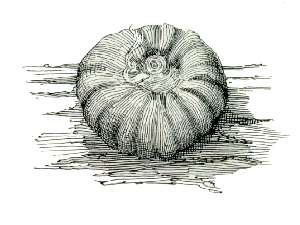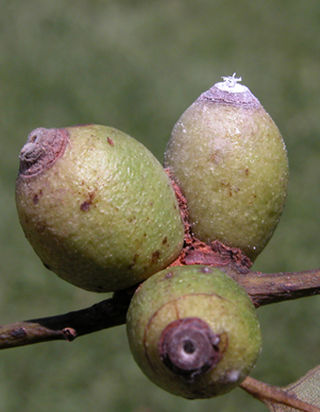
Scale insects are small insects of the order Hemiptera, suborder Sternorrhyncha. Of dramatically variable appearance and extreme sexual dimorphism, they comprise the infraorder Coccomorpha which is considered a more convenient grouping than the superfamily Coccoidea due to taxonomic uncertainties. Adult females typically have soft bodies and no limbs, and are concealed underneath domed scales, extruding quantities of wax for protection. Some species are hermaphroditic, with a combined ovotestis instead of separate ovaries and testes. Males, in the species where they occur, have legs and sometimes wings, and resemble small flies. Scale insects are herbivores, piercing plant tissues with their mouthparts and remaining in one place, feeding on sap. The excess fluid they imbibe is secreted as honeydew on which sooty mold tends to grow. The insects often have a mutualistic relationship with ants, which feed on the honeydew and protect them from predators. There are about 8,000 described species.

The Sternorrhyncha suborder of the Hemiptera contains the aphids, whiteflies, and scale insects, groups which were traditionally included in the now-obsolete order "Homoptera". "Sternorrhyncha" refers to the rearward position of the mouthparts relative to the head.

The Margarodidae or ground pearls are a family of scale insects within the superfamily Coccoidea. Members of the family include the Polish cochineal and Armenian cochineal and the original ground pearl genus, Margarodes. Beginning in 1880, a number of distinct subfamilies were recognized, with the giant coccids being the first. Although Maskell proposed a new family, many continued to regard the monophlebids as a mere subfamily for many years, and the Margarodidae classification continued to be polyphyletic through the 20th Century. Since then, taking the advice of Koteja several subfamilies and tribes have been elevated into their own families such as Matsucoccidae and Xylococcidae. The pared-down family of Margarodidae is monophyletic.

Kerria lacca is a species of insect in the family Kerriidae, the lac insects. These are in the superfamily Coccoidea, the scale insects. This species is perhaps the most commercially important lac insect, being a main source of lac, a resin which can be refined into shellac and other products. This insect is native to Asia.

Kerriidae is a family of scale insects, commonly known as lac insects or lac scales. Some members of the genera Metatachardia, Tachardiella, Austrotacharidia, Afrotachardina, Tachardina, and Kerria are raised for commercial purposes, though the most commonly cultivated species is Kerria lacca. These insects secrete a waxy resin that is harvested and converted commercially into lac and shellac, used in various dyes, cosmetics, food glazes, wood finishing varnishes and polishes.
Conchaspididae is a small family of scale insects known as false armoured scales because of their resemblance to Diaspididae.

Coccus is a genus of scale insects in the family Coccidae. Several species, such as Coccus viridis, a major pest of coffee, are major agricultural pests. The type species is Coccus hesperidumLinnaeus.

Pulvinaria is a scale insect genus in the family Coccidae. The type species is Coccus vitis Linnaeus.
Phenacoleachiidae is a family of scale insects commonly known as the phenacoleachiids. They are found only in the South Island of New Zealand, and on certain offshore islands. There are two species in a single genus.
Augulaspidina is a subtribe of armored scale insects. It was not confirmed by Takagi's 2002 study.
Rugaspidiotina is an obsolete subtribe of armored scale insects. It was established by Balachowsky in 1949 to accept those Diaspidinae which had rugaspidiotine characteristics as exemplified by genus Rugaspidiotus MacGillivray, species Rugaspidiotus arizonicus, and was moved from the Odonaspidini to the Diaspidini by Borchsenius. It was raised to tribe status as Rugaspidiotini. However, close examination of species assigned to the Rugaspidiotini showed that the rugaspidiotine characteristics convergently evolved in different groups of diaspidids. Rugaspidiotini and Rugaspidiotina are now regarded as obsolete groupings.

Apiomorpha is a genus of scale insect that induces galls on species of Eucalyptus. Galls are initiated by first-instar nymphs (crawlers) on new plant growth and, when mature, the galls exhibit marked sexual dimorphism. Those induced by females are among the largest and most spectacular of arthropod-induced galls whereas those of males are small and most are tubular. Apiomorpha is known only from Australia and New Guinea although its host, Eucalyptus, has a wider distribution into Indonesia as well.

Cylindrococcus is a genus of scale insects that induces galls on plants of the genus Allocasuarina. There are two described species of Cylindrococcus, both of which occur only in Australia. The galls of adult females look somewhat similar to the cone-like "fruit" of the host plant and might be mistaken for such.

Callococcus is a genus of Australian scale insect that feeds on species of Leptospermum, Hypocalymma, Kunzea and some other members of the tribes Chamelaucieae and Leptospermeae in the myrtle family Myrtaceae. Callococcus leptospermi induces stem-swelling galls on some species of Leptospermum, and it is considered to be a potential biological control agent of Leptospermum laevigatum in South Africa. The other described species of Callococcus do not induce galls.
John Stuart Noyes is a Welsh entomologist.
Trabutina mannipara, or mana scale, is a species of mealybug found in the Middle East and southern Europe. It is the most well-known of the five species in the genus Trabutina, of which it is the type species, due to its association with the biblical story of manna. T. mannipara feeds parasitically on tamarisk trees, and excretes a sweet substance which is sometimes collected for human consumption. Obsolete terms for it include Coccus manniparus and Trabutina palestina. This species can be found in the Sinai and Iraq.
Trabutina is a genus of "blue-green" mealybugs, containing five species: T. crassispinosa, T. elastica, T. mannipara, T. serpentina, and T. tenax. This genus of scale insects feeds solely on plants of the genus Tamarix. Its type species is T. mannipara.

Paratachardina is a genus of true bugs belonging to the family Kerriidae.
Paratachardina lobata, the lobate lac scale, is a polyphagous lac scale insect, which damages trees and woody shrubs. It is native to India and Sri Lanka, but has been introduced to Florida where it is regarded as an invasive species.
Ferrisia is a genus of mealybugs.









